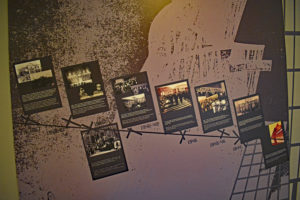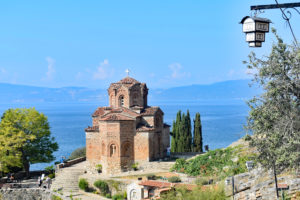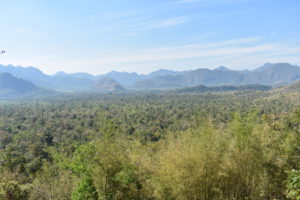The “Hellfire Pass Interpretive Centre and Memorial Walk”:https://www.dva.gov.au/commemorations-memorials-and-war-graves/memorials/war-memorials/thailand documents the building of the Thailand to Burma railway, with an emphasis on Konyu Cutting. Its other name, Hellfire Pass, came from the appalling conditions suffered by Prisoners of War, particularly in mid-1943, when the Japanese introduced ‘speedo’. This meant working through the night, using oil lamps and bamboo fires for light, drilling the solid rock and removing it by hand.
The centre, funded by the Australian Government, had just been renovated and we were amongst the first visitors. We walked down an illuminated, simulated rail track which opened into exhibition rooms with well-lit, easy to read information boards in English and Thai. As well as explaining the history, there were extracts from interviews with Australian veterans and evocative sketches drawn at the time. The centrepiece was a mass of rock demonstrating the volume that a single POW would have to move each day and in stark contrast, the small bowl of rice he would have received. It was a striking depiction.
Before setting off on the memorial walk, you’re advised to wear sturdy shoes, carry water, wear a hat and sunscreen. The walk is not circular and If you intend to do the full route, it’s suggested that you notify the museum and ask for a radio as there’s no help provided on the walk.
Having picked up headphones and a map, we began our journey on the Memorial Walk. A timber boardwalk and long flight of stairs took us down to the railway line which still had some of the original wooden sleepers. At various points display boards provided information and our headphone played evocative testimonies from the POWs. As we walked through bamboo groves, we heard how the wood played a major part in every element of daily life. The track led us to the cutting where we saw examples of the hand tools used to carve it out (the Japanese had discounted the use of heavy tunnelling machinery). The track was made of large stone chips and walking wasn’t easy and we were grateful for sturdy walking boots. In the middle of Konyu Cutting was a lone, tall self-seeded rubber tree.
We eventually reached the marble memorial with the flags of the countries involved: US, Thai, UK, Dutch and Australian. Here, on ANZAC day, 25 April, a dawn ceremony is held in commemoration of those who lost their lives.
Continuing onwards, we walked as far as the viewpoint overlooking the Khwae Noi Valley, which would have contained teak forests, before turning back. Although the entire walk is only 3.5km, notices inform you that from this point the terrain is much more difficult.
We returned a slightly different route which involved climbing 160 steps.
As it’s funded by the Australians, it’s naturally Australian-centric and at one point, we did wonder about the role played by the British and others. However, we learned that the Australians were vaccinated for cholera before the war, and therefore suffered less fatalities from the disease than the British.
We visited the centre whilst staying nearby at Hintok River Camp, but it could be done as a day trip from Bangkok.










